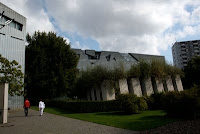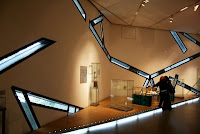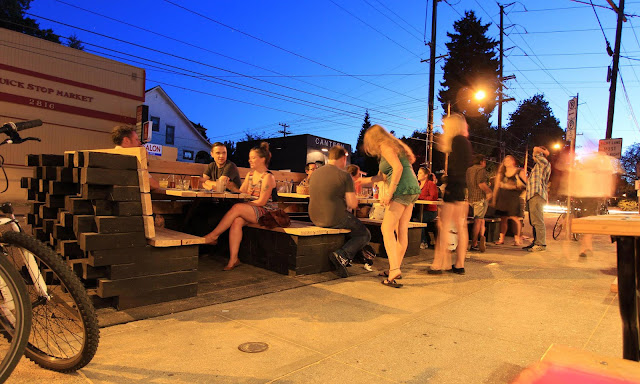The Jewish Museum
Berlin, Germany – designed by Daniel Libeskind
By Lucas Gray
 The Jewish Museum in Berlin exploded onto the international architecture scene in 2001 with great fanfare. A truly unique design by Daniel Libeskind - the jagged volume cut by jarring windows is said to allude to the struggles and hardships the Jewish people have overcome throughout a troubled history. The design evolved from a deconstruction of the Star of David slowly evolving into its present form. This symbolic shape was disassembled and morphed into a long meandering building that bends and folds back off of the main street into a tranquil garden. It has an extreme contrast to the historic building it extends from and is an eye catching form that attracts visitors as much for the architecture as for the museum's content.
The Jewish Museum in Berlin exploded onto the international architecture scene in 2001 with great fanfare. A truly unique design by Daniel Libeskind - the jagged volume cut by jarring windows is said to allude to the struggles and hardships the Jewish people have overcome throughout a troubled history. The design evolved from a deconstruction of the Star of David slowly evolving into its present form. This symbolic shape was disassembled and morphed into a long meandering building that bends and folds back off of the main street into a tranquil garden. It has an extreme contrast to the historic building it extends from and is an eye catching form that attracts visitors as much for the architecture as for the museum's content.
 The exterior is truly captivating. The metal cladding has ever evolving moods as it reflects hues from the sky and surroundings. At dusk, the walls turn subtle pinks and oranges that contrast against the dark gray of the planes that face away from the setting sun. As the building twists and turns small courtyards emerge housing symbolic gardens or hard-scaped plazas. Wandering around the structure gives the visitor an ever-changing ambiance with tight sharp spaces adjacent to open airy gardens.
The exterior is truly captivating. The metal cladding has ever evolving moods as it reflects hues from the sky and surroundings. At dusk, the walls turn subtle pinks and oranges that contrast against the dark gray of the planes that face away from the setting sun. As the building twists and turns small courtyards emerge housing symbolic gardens or hard-scaped plazas. Wandering around the structure gives the visitor an ever-changing ambiance with tight sharp spaces adjacent to open airy gardens.
However, this bold statement as a piece of sculpture in the landscape loses credibility when seen from within. As a museum this building is a terrible disappointment. From the questionable curation, the quality and interest of the exhibits, to the confusing procession, the interior is rather poorly done. As you descend a dark yet beautiful staircase to enter the first exhibit space you expect to emerge in an interior that reflects the beauty and complexity of the exterior. Instead you are left feeling flat as a long straight corridor lit with fluorescent lights opens before you. Small exhibits and artifacts relating to the holocaust are inset into the gypsum board walls. The content and stories being told deserve to be celebrated in a more elegant space than currently exists. The materials feel cheap, the detailing is poorly done, and the lighting is atrocious. As was pointed out to me, Libeskind didn't design the exhibits. However, he was still responsible for choices of materials and detailing which fell short in my opinion.
 A glimmer of hope arises as you move up another grand staircase that brings you to the start of the main exhibition space. Flying concrete beams pierce the three-story space above you and generate dramatic shadows and a feeling of intense movement. Looking back down after the hard climb offers an intriguing view of a unique architectural space. But the fact that it revolves around a 3 story climb up stairs limits its effect as many visitors just can’t physically accomplish it. It creates a terrible social injustice, especially with an increasing elderly Jewish population.
A glimmer of hope arises as you move up another grand staircase that brings you to the start of the main exhibition space. Flying concrete beams pierce the three-story space above you and generate dramatic shadows and a feeling of intense movement. Looking back down after the hard climb offers an intriguing view of a unique architectural space. But the fact that it revolves around a 3 story climb up stairs limits its effect as many visitors just can’t physically accomplish it. It creates a terrible social injustice, especially with an increasing elderly Jewish population.
Once you do enter the exhibits you find kitschy displays, rather uninteresting artifacts and a space that is unemotional, unmoving, and rather unattractive. Its confusing as how to move through the exhibit, the lighting is terrible, and the small slashes of windows don’t let in natural light, don’t let out good views and reveal more poor detailing. More whitewashed gypsum board walls move you through the interior that is an ultimately forgetful experience.
 Now I would be ready to give the architect Mr. Libeskind the benefit of the doubt. He was attempting to create a bold, unique form that symbolically related to a very touch history – especially here in Germany. However, since completion of this museum he has gone on too use the same jagged planes, slashed windows, and bland materials on dozens of projects since. I feel this takes away from the symbolism offered as an explanation for this outlandish form. From the Denver Art Museum, to the Royal Ontario Museum in Toronto, to the Contemporary Jewish Museum in San Francisco, Daniel Libeskind has created overly complex geometries without actually making great architecture. He has spent millions of taxpayers’ dollars without giving the people a building that will stand the test of time and become a symbol of their city’s culture.
Now I would be ready to give the architect Mr. Libeskind the benefit of the doubt. He was attempting to create a bold, unique form that symbolically related to a very touch history – especially here in Germany. However, since completion of this museum he has gone on too use the same jagged planes, slashed windows, and bland materials on dozens of projects since. I feel this takes away from the symbolism offered as an explanation for this outlandish form. From the Denver Art Museum, to the Royal Ontario Museum in Toronto, to the Contemporary Jewish Museum in San Francisco, Daniel Libeskind has created overly complex geometries without actually making great architecture. He has spent millions of taxpayers’ dollars without giving the people a building that will stand the test of time and become a symbol of their city’s culture.
By Lucas Gray
 The Jewish Museum in Berlin exploded onto the international architecture scene in 2001 with great fanfare. A truly unique design by Daniel Libeskind - the jagged volume cut by jarring windows is said to allude to the struggles and hardships the Jewish people have overcome throughout a troubled history. The design evolved from a deconstruction of the Star of David slowly evolving into its present form. This symbolic shape was disassembled and morphed into a long meandering building that bends and folds back off of the main street into a tranquil garden. It has an extreme contrast to the historic building it extends from and is an eye catching form that attracts visitors as much for the architecture as for the museum's content.
The Jewish Museum in Berlin exploded onto the international architecture scene in 2001 with great fanfare. A truly unique design by Daniel Libeskind - the jagged volume cut by jarring windows is said to allude to the struggles and hardships the Jewish people have overcome throughout a troubled history. The design evolved from a deconstruction of the Star of David slowly evolving into its present form. This symbolic shape was disassembled and morphed into a long meandering building that bends and folds back off of the main street into a tranquil garden. It has an extreme contrast to the historic building it extends from and is an eye catching form that attracts visitors as much for the architecture as for the museum's content. The exterior is truly captivating. The metal cladding has ever evolving moods as it reflects hues from the sky and surroundings. At dusk, the walls turn subtle pinks and oranges that contrast against the dark gray of the planes that face away from the setting sun. As the building twists and turns small courtyards emerge housing symbolic gardens or hard-scaped plazas. Wandering around the structure gives the visitor an ever-changing ambiance with tight sharp spaces adjacent to open airy gardens.
The exterior is truly captivating. The metal cladding has ever evolving moods as it reflects hues from the sky and surroundings. At dusk, the walls turn subtle pinks and oranges that contrast against the dark gray of the planes that face away from the setting sun. As the building twists and turns small courtyards emerge housing symbolic gardens or hard-scaped plazas. Wandering around the structure gives the visitor an ever-changing ambiance with tight sharp spaces adjacent to open airy gardens.However, this bold statement as a piece of sculpture in the landscape loses credibility when seen from within. As a museum this building is a terrible disappointment. From the questionable curation, the quality and interest of the exhibits, to the confusing procession, the interior is rather poorly done. As you descend a dark yet beautiful staircase to enter the first exhibit space you expect to emerge in an interior that reflects the beauty and complexity of the exterior. Instead you are left feeling flat as a long straight corridor lit with fluorescent lights opens before you. Small exhibits and artifacts relating to the holocaust are inset into the gypsum board walls. The content and stories being told deserve to be celebrated in a more elegant space than currently exists. The materials feel cheap, the detailing is poorly done, and the lighting is atrocious. As was pointed out to me, Libeskind didn't design the exhibits. However, he was still responsible for choices of materials and detailing which fell short in my opinion.
 A glimmer of hope arises as you move up another grand staircase that brings you to the start of the main exhibition space. Flying concrete beams pierce the three-story space above you and generate dramatic shadows and a feeling of intense movement. Looking back down after the hard climb offers an intriguing view of a unique architectural space. But the fact that it revolves around a 3 story climb up stairs limits its effect as many visitors just can’t physically accomplish it. It creates a terrible social injustice, especially with an increasing elderly Jewish population.
A glimmer of hope arises as you move up another grand staircase that brings you to the start of the main exhibition space. Flying concrete beams pierce the three-story space above you and generate dramatic shadows and a feeling of intense movement. Looking back down after the hard climb offers an intriguing view of a unique architectural space. But the fact that it revolves around a 3 story climb up stairs limits its effect as many visitors just can’t physically accomplish it. It creates a terrible social injustice, especially with an increasing elderly Jewish population.Once you do enter the exhibits you find kitschy displays, rather uninteresting artifacts and a space that is unemotional, unmoving, and rather unattractive. Its confusing as how to move through the exhibit, the lighting is terrible, and the small slashes of windows don’t let in natural light, don’t let out good views and reveal more poor detailing. More whitewashed gypsum board walls move you through the interior that is an ultimately forgetful experience.
 Now I would be ready to give the architect Mr. Libeskind the benefit of the doubt. He was attempting to create a bold, unique form that symbolically related to a very touch history – especially here in Germany. However, since completion of this museum he has gone on too use the same jagged planes, slashed windows, and bland materials on dozens of projects since. I feel this takes away from the symbolism offered as an explanation for this outlandish form. From the Denver Art Museum, to the Royal Ontario Museum in Toronto, to the Contemporary Jewish Museum in San Francisco, Daniel Libeskind has created overly complex geometries without actually making great architecture. He has spent millions of taxpayers’ dollars without giving the people a building that will stand the test of time and become a symbol of their city’s culture.
Now I would be ready to give the architect Mr. Libeskind the benefit of the doubt. He was attempting to create a bold, unique form that symbolically related to a very touch history – especially here in Germany. However, since completion of this museum he has gone on too use the same jagged planes, slashed windows, and bland materials on dozens of projects since. I feel this takes away from the symbolism offered as an explanation for this outlandish form. From the Denver Art Museum, to the Royal Ontario Museum in Toronto, to the Contemporary Jewish Museum in San Francisco, Daniel Libeskind has created overly complex geometries without actually making great architecture. He has spent millions of taxpayers’ dollars without giving the people a building that will stand the test of time and become a symbol of their city’s culture.





